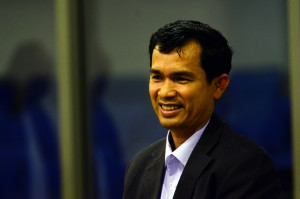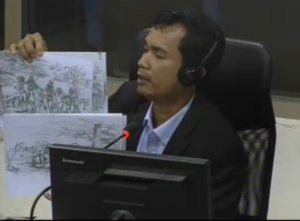Looking At Skulls: Analysis of Remains at Choeung Ek
Anonymous witness 2-TCW-823 concluded his testimony today. He provided information regarding armed clashes between Democratic Kampuchea and Vietnam as well as his meeting with Khieu Samphan.
In the afternoon, expert Voeun Vuthy was heard. He provided the chamber with information about the skulls he and his team had analyzed at Choeung Ek: he explained what methods they had used to determine the gender and causes of death of traces of violence they had found on the remains.
Preliminary Issues
Trial Chamber President Nil Nonn inquired about Civil Party Sar Sarin’s status. National Civil Party Lead Co-Lawyer Pich Ang informed the Chamber that Mr. Sarin wished to retain his Civil Party status (see discussion here.)
The floor was handed to the Nuon Chea Defense Team. Counsel Victor Koppe referred to the upcoming expert’s testimony and pointed to the Kraing Ta Chan study this expert had conducted. Mr. Koppe said there was no translation of the relevant portions yet. He requested clarification with regards to the OCIJ staff member and whether she would testify today. Khieu Samphan Defense Counsel Anta Guissé supported the question regarding the Kraing Ta Chang Report. She asked whether it was possible to break the examination in two parts: one this week and the second part in January. Presiding Judge Nil Nonn informed the parties that they had been told the translation would be ready this morning, but that they had not yet received the translation. A decision would be rendered when witness 2-TCW-823 was concluded.
Armed Clashes with Vietnam
Mr. Koppe then started the examination of the witness. He asked what his unit would do when they saw a fishing boat enter the territorial waters of Democratic Kampuchea. The witness replied that they mobilized the forces to protect their island. “There was a gun exchange between their side and our side.” Mr. Koppe asked what happened if a real fishing boat encroached onto Cambodian territory. He replied that this would not happen and that there were usually armed clashes. Mr. Koppe said that 2-TCW-1008 (Meas Voeun) had said that they would deploy the ships to see whether it was a fishing boat or an armed boat; they would chase away fishing boats. The witness confirmed that they would chase fishing boats away when they entered Cambodian territorial waters. However, if the Democratic Kampuchea patrols were fired upon, they would return fire. Mr. Koppe asked whether they made a difference how far a ship came into the territory.[1] He answered that if they entered beyond Koh Seh and fired upon, they would return fire. They would enter Cambodian territories every once in a while. They had AK-47 rifles and B-40 rockets.
Mr. Koppe inquired whether his unit also encountered Thai fishing boats. He replied that they were not close to Thailand and therefore did not have any interaction with Thai.
Mr. Koppe referred to another person’s testimony, who had said that there was an instruction in Division 164 not to fire on Thai fishermen.[2] The witness replied that he had different instructions and that he did not know what kind of instructions other spearheads received. He received instructions not to sink the Vietnamese fishing boats. Mr. Koppe asked whether he was aware of Vietnamese civilians trying to get to Thailand.[3] The witness answered that he did not know. Mr. Koppe asked whether he knew of any orders within Division 164 not to touch Thai people. He answered that he was not aware of instructions regarding Thai people. As for Thai fishermen, they were told to return, unless they fired – in which case they would be fired upon. Vietnamese refugees were not perceived as enemies, as they were merely fleeing and were not armed. “We, the soldiers, could not attack or mistreat them.” The instructions were to allow them to flee. He said he considered it normal that there were sporadic clashes.
Mr. Koppe asked whether it was correct that his unit never invaded the Vietnamese boundary. He said that they would counter fire without invading Vietnamese territory.
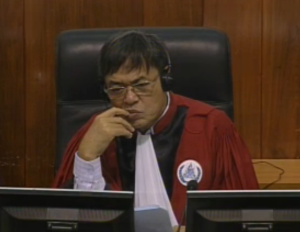
Trial Chamber President Nil Nonn
Mr. Koppe whether he remembered who instructed them “not to seek trouble with Vietnam”, because Democratic Kampuchea was small and Vietnam was larger.[4] The witness answered that “the policy of Democratic Kampuchea was not to invade another country.” Cambodia had a small population and only tried to defend their country. He knew Ieng Pan who had given information to the same effect (see here and here for a summary of his testimony). Mr. Koppe wanted to know what he knew about him and whether he had worked with him. He said that he currently is part of the zone and a major general. The witness used to work with him. He was reintegrated into Cambodian Royla Armed Forces. Mr. Koppe asked whether it was a policy of “each and every soldier” that Cambodian should not attack Vietnam. The witness confirmed this. “It was my understanding that the instruction was proper.” However, if they were attacked they had to retaliate. “We were like an ant and they were like an elephant. How could we invade?” Mr. Koppe quoted Son Sen, who had said that they would not “be the one who make trouble”.[5] The witness replied that this was the instruction to all soldiers. Mr. Koppe quoted another witness, who had quoted Ta Mok as giving instructions regarding he conflict with Vietnam.[6] The witness said he received these instructions from “Pol Pot’s documents.” He said that he read them and that divisional commanders also confirmed these orders. They issued documents that were used in study sessions.
At this point, the President adjourned the hearing for a break.
Follow-up Questions by Judge Lavergne
After the break, Judge Nonn informed the parties that the Kraing Ta Chang document was now translated and placed on the case file. The president would put introductory questions to the expert and then adjourn. The parties would then have the opportunity to put questions to the witness tomorrow. Witness 2-TCW-1042 was on the reserve tomorrow.
Judge Jean-Marc Lavergne asked who issued the instructions to him if they were not from the division, as he had said that he did not receive instructions from the division. He said he received instructions through the regiment. Judge Lavergne asked whether he had understood him correctly that it was not possible for Vietnamese fishermen to enter the territorial waters under the witness’s authority. He replied that fishing boats were mounted with weapons. He never saw boats carrying refugees. Judge Lavergne wanted to know whether anyone checked whether there were civilians on the boat. He answered that they would go back to their own islands and the Vietnamese would take their injured soldiers back to their territory. “I did not go to crosscheck whether or not they were soldiers. Anyone who was armed and fired at us, we would fire back at them.” He never saw Vietnamese ships and only saw boats.
Khieu Samphan

Khieu Samphan Defense Counsel Anta Guissé
The floor was handed to Khieu Samphan Defense Counsel Anta Guissé. She asked who the person Chhum was. He replied that he knew him, but did not know what Chhum’s duties were. She wanted to know what he meant when he said that he saw Khieu Samphan at a meeting but did not speak with him.[7] He replied that the Vietnamese were attacking at the time. He did not recall where it took place. The meeting was convened in a house. There were no guards securing the place. He had met him before the arrival of the Vietnamese. The information they received was that the Vietnamese were approaching, but he did not know their exact location. Ms. Guissé asked how he knew that this was Khieu Samphan. He replied that he knew him before the meeting. He saw his photograph prior to the meeting.
Evacuation of Workers
Ms. Guissé asked whether he remembered the itinerary of the workers he had to evacuate from the factories and how they were transported. He replied that they went to Battambang and Pursat Provinces. Some were transported by vehicles and others were travelling on foot. The evacuation was done in a hurry. He was by himself while his forces were still at Kampong Saom. The majority of workers had left and he was in a vehicle. In the meeting, they were informed about the plan and there was a rumor that the Vietnamese troops were approaching. He could not recall the exact date of the meeting. Ms. Guissé asked whether he was certain that the meeting took place in December and not in January on the eve of the arrival of the troops. He distributed papers at a factory. When he heard that the Vietnamese troops were approaching, they held a meeting in a factory so that they could prepare themselves. The meeting was attended by the witness and the workers.
The witness was not aware of any forced marriages. A series of weddings took place, but he had not heard of them being forced.
At this point, the President adjourned the hearing for a break.
Expert Testimony: Voeun Vuthy
After the lunch break, the chamber commenced to hear expert 2-TCE-1062.
Voeun Vuthy was born on December 5 1973. He presently works for the Ministry of Fine Arts. He studied anthropology at the University of Fine Arts and then studied in Japan and Bologna, Italy. He also studied at University of Hawaii in bone conversation and remains. His highest degree is a master’s degree. He was involved in research regarding archeology relating to human bones in 1988. He also did research on the gathering of remains and remains of pre-history. He participated in historical research in 1999. In 1990, he participated in a research project in the eastern part of Cambodia regarding pre-history. From 2006 to 2007, he participated in the study of the Angkorian era. He later conducted research with particular focus on changes from one kingdom to another. In 2010, he conducted research with regards to human bones in Hawaii. Lately, he conducted research regarding bone remains at Choeung Ek and Kraing Ta Chan, as well as Prasat Padei and Kok Prech. His was the director of the project leading the conversation of the victim remains. The second purpose of the analysis was to compile a historical document in order for the next generation to avoid the return of the regime. The third purpose was to document torture inflicted on the victims. All four projects will be concluded in their entirety by the end of this month. He was interested in this, as he was also a victim: he lost his father and a total of six members of his family.
He saw that the bones decayed at Choeung Ek and realized that they would be lost if not preserved properly. They had experts participating from Kosovo, the United States, New Zealand, and England, who cooperated with them to assist them in the analysis of the human remains. They started in 2013 and it continued until 2015. As for the documents, they compiled three parts: first, the database. Second, a book. Third, on a digital form. They cleaned the bones. Before this, they would take photographs. After the cleaning, they compared the marks on the bones that were photographed. They analyzed the gender, age, and cause of death. They also had to analyze how many traces of traumas there were on the skeleton. They then analyzed what kind of tool was used to inflict the trauma on the body: was it a knife? A club? A stick? An axe?
After such analysis, they proceeded to the next step: to conserve the marks so that they would not be lost. They would then conserve the remains. They then documented all steps they had undertaken. They interviewed witnesses in three stages: those who came to the site and who witnessed the corpses of the victims so that the researchers could evaluate the graves. Second, those who entered the area during the Pol Pot regime, such as Him Huy. For the third stage, they interviewed those who may have witnessed the killing of transportation to the crime site.
They then drew sketches and took photographs. He showed a few examples of skulls and sketches they had done. At this point, Ms. Guissé interjected and said that the pictures would have to be attached to the transcript.
Causes of Death
The expert said he had 32 books and examined 6,426 skulls. The research they had conducted focused on the victims at Choeung Ek. There were 6,426 remains at Choeung Ek. They had found 28,083 traces on the victims. “Some of them were killed by bamboo.”
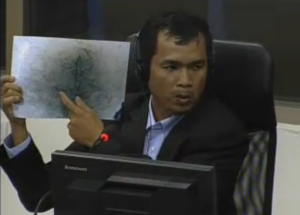
Expert Voeun Vuthy shows a skull that showed the victim had undergone torture
4,802 showed traces of injuries inflicted by iron clubs. 5,806 showed signs of another iron tool, and 3,563 showed traces of hoes. 541 showed that they were hit with the back of a hoe. 101 were hit with an ax. 165 showed traces of bullets, and 990 that of a bayonet. 48 were killed by being hit on the back of the neck. 286 skulls showed traces of chemical elements and 38 remains showed that they were victims of torture. He said that 758 showed that an iron was poked into their ears (this may have been a translation issue: the president later asked about the cutting off of ears).
Ms. Guissé asked for references. Mr. Koppe said that it seemed that the expert using a document that was on the case file, but used total numbers instead.[8] Mr. Lysak said that the total numbers were to be found in two documents that were also on the case file.[9]
Methods
The president informed the expert that he should summarize his findings. Detailed questions would be put to him tomorrow. In order to identify the victims who died during the regime, they used “certain documents” and looked at the remains. They first analyzed the site and then the remains. They needed to thoroughly examine the remains in order to establish whether they died in the graves and during the Khmer Rouge regime. They also analyzed remains that dated 2,500 years ago. He said that it was therefore difficult to explain the underlying expertise of the analysis.
They did not conduct a DNA analysis or C14 (which is a method using radiocarbon). Thus, they could only analyze the gender of the victims. They found 129 sites at Choeung Ek, but they could only examine 86 graves.
The president then inquired how they determined that the victims died at Kraing Ta Chan. Mr. Vuthy replied that they analyzed the mud that was dug out with the victims. The remains would usually not come with the mud, he said.
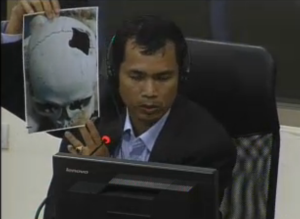
A fractured skull.
At Choeung Ek, they could fund only one skull that had not been inflicted by torture or heavy beating among the 6,426 skulls found. The president asked how they found out that some of the remains showed signs of violence. He answered that they looked at the traces of the remains. He gave an example of a skull that showed signs of a heavy impact of a long bar. They examined the skulls under microscopes. As for chemical elements, Mr. Vuthy explained that poison usually transformed the color of the bones. The bones where the lips were positioned would also change color. In addition, they sent the remains to colleagues abroad to have confirmation.
The president said that: “I am not really an expert in that field, and I’m really explanation.” He wanted to know how he knew that some of skulls showed that the ears were cut off. The expert replied that while the ear could not be seen on the skull, the scar on the bone next to the ear would be shown. “Usually when the ear is cut off, there are many traces.”
They had found out that many people died while being shackled or tied up. They could determine this, because there were scars and because the knots would usually remain with the bodies. They had found ten types of tools, including axes, ion bars, knives, iron rods, and square wood.
Gender
Next, the president wanted to know how he found out the age and gender of the victims. Mr. Vuthy explained that they used internationally recognized methods. For example, they would first look at the eye brows that were different according to the gender. The ear lobe was also different. There were seven criteria in total. Furthermore, there were lines on the skulls that indicated the age. They found 1,611 female and 4,798 male remains (plus 17 whose gender could not be determined). They had divided them into six categories: 1) Aged 3-8: They found two males and 11 females; 2) Aged 8-19: of a total of 241, they found 74 males and 167 females; 3) Aged 20-34: Of a total of 3,984 skulls, they found 2,845 male and 1,127 females and 12 unidentifiable skulls; 4) Aged 35-49: Of a total of 1,894, they found 1,318 males and 575 females (the interpreter said 2,075, but this must have been an interpretation error). In addition, there was one that could not be determined. 5) Aged 50-69: Of a total of 273, they found 245 males and 27 female, as well as one that could not be determined. 6) 70 and above: They found 18 in total, 14 of which were male, and 4 of which were female. Three skulls were found whose gender could not be determined (Note: the numbers do not add up. It is not clear whether this is due to interpretation errors or errors made on the side of the expert.)
At this point, the president said that he had no further questions for the expert. As no other judges had questions for the expert, the chamber adjourned. The parties would put questions to the witness tomorrow, as one part of the study was only translated into English today.
[1] E3/9398, at answer 18.
[2] Testimony of Meas Voeun on 2 February 2016.
[3] E3/9699, at answer 75.
[4] E3/9698, at answer 24.
[5] E3/799, at 00184781 (EN), 00083160 (KH), 0032316 (FR).
[6] E3/8752, at 00848511 (EN), 00733339 (KH), 01309293 (FR).
[7] E3/9817a, at 01308963 (FR), 01313343 (EN), 01033989 (KH).
[8] E3/10648, at 01324883 (EN).
[9] E3/10765; E3/10766.

